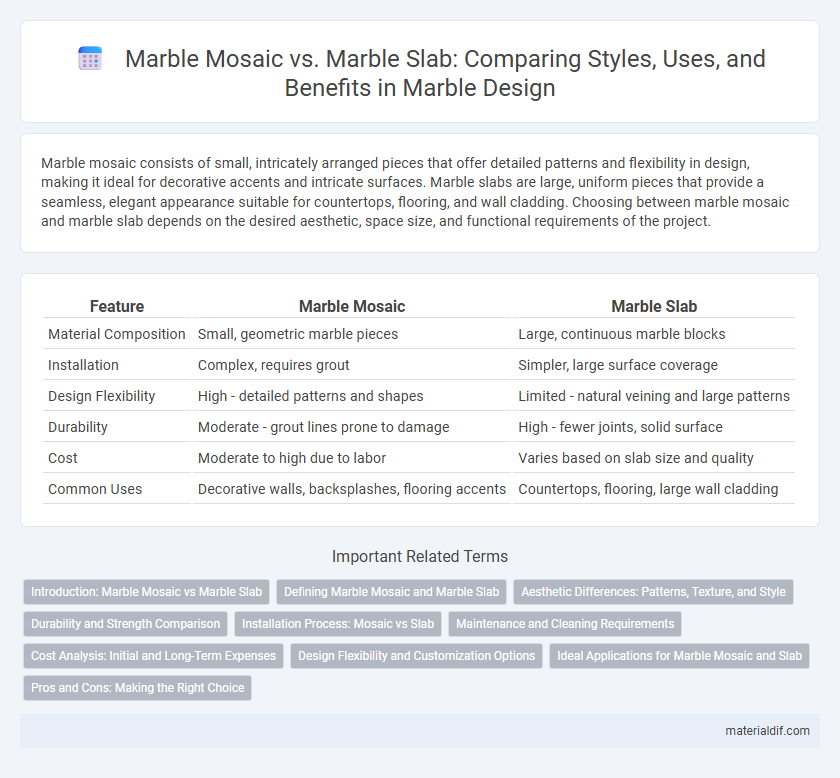Marble mosaic consists of small, intricately arranged pieces that offer detailed patterns and flexibility in design, making it ideal for decorative accents and intricate surfaces. Marble slabs are large, uniform pieces that provide a seamless, elegant appearance suitable for countertops, flooring, and wall cladding. Choosing between marble mosaic and marble slab depends on the desired aesthetic, space size, and functional requirements of the project.
Table of Comparison
| Feature | Marble Mosaic | Marble Slab |
|---|---|---|
| Material Composition | Small, geometric marble pieces | Large, continuous marble blocks |
| Installation | Complex, requires grout | Simpler, large surface coverage |
| Design Flexibility | High - detailed patterns and shapes | Limited - natural veining and large patterns |
| Durability | Moderate - grout lines prone to damage | High - fewer joints, solid surface |
| Cost | Moderate to high due to labor | Varies based on slab size and quality |
| Common Uses | Decorative walls, backsplashes, flooring accents | Countertops, flooring, large wall cladding |
Introduction: Marble Mosaic vs Marble Slab
Marble mosaic consists of small, intricately cut pieces of marble assembled into decorative patterns, offering versatility and detailed design for walls, floors, and backsplashes. Marble slab features large, continuous pieces of natural stone, prized for its uniformity and dramatic, flowing veining, making it ideal for countertops and expansive surfaces. Both materials provide unique aesthetic qualities and durability, but marble mosaic emphasizes artistic texture while marble slab highlights bold elegance.
Defining Marble Mosaic and Marble Slab
Marble mosaic consists of small, intricately cut pieces of marble arranged to create decorative patterns or images, making it ideal for artistic and detailed flooring or wall designs. Marble slabs are large, continuous sheets of natural marble, prized for their uniform surface and strength, commonly used in countertops, flooring, and large-scale installations. Both materials showcase the natural beauty and durability of marble but differ significantly in their form, application, and aesthetic impact.
Aesthetic Differences: Patterns, Texture, and Style
Marble mosaic features intricate, small pieces arranged in repeating patterns that create a textured and visually dynamic surface, ideal for artistic and decorative applications. In contrast, marble slabs offer a smooth, continuous surface showcasing natural veining and bold, sweeping patterns that emphasize elegance and sophistication in minimalist designs. The choice between marble mosaic and slab dramatically influences the interior ambiance, with mosaics providing detailed complexity and slabs delivering seamless grandeur.
Durability and Strength Comparison
Marble mosaics consist of small, interlocked pieces providing flexible design options but generally exhibit slightly lower durability due to numerous grout lines that can be prone to cracking and staining. Marble slabs, cut as large, solid pieces, offer enhanced strength and structural integrity, making them more resistant to heavy impact and wear over time. For applications demanding maximum durability and longevity, marble slabs are typically the preferred choice due to their seamless surface and robust composition.
Installation Process: Mosaic vs Slab
Marble mosaic installation involves placing small, pre-cut marble pieces on a mesh backing, allowing for easier alignment and faster application, ideal for intricate designs or curved surfaces. Marble slab installation requires handling large, heavy pieces that need precise cutting and leveling to ensure a seamless, flat surface, demanding skilled labor and more time. Both methods necessitate a strong adhesive base and proper sealing, but mosaic tiles offer more flexibility while slabs provide a luxurious, continuous look.
Maintenance and Cleaning Requirements
Marble mosaic, composed of small, interconnected pieces, demands more frequent grout cleaning and sealing to prevent dirt accumulation and staining. Marble slabs, with their larger continuous surface, are easier to clean and maintain, requiring less grout upkeep but still needing regular sealing to preserve their polish. Both types benefit from using pH-neutral cleaning agents to avoid etching and maintain their natural luster over time.
Cost Analysis: Initial and Long-Term Expenses
Marble mosaic typically incurs lower initial costs due to smaller tile sizes and simpler installation compared to marble slabs, which demand higher upfront investment because of larger, heavier pieces and specialized labor. Long-term expenses for marble slabs can be greater given their susceptibility to cracking and the need for professional refinishing, whereas marble mosaics offer easier, more cost-effective repairs by replacing individual tiles. Evaluating overall cost-effectiveness depends on project scale, maintenance frequency, and desired aesthetic durability.
Design Flexibility and Customization Options
Marble mosaics offer unmatched design flexibility through intricate patterns and diverse shapes, making them ideal for creating detailed and personalized decor. Marble slabs provide large, continuous surfaces with natural veining that suit minimalist designs but limit customization compared to mosaics. Choosing between marble mosaic and slab depends on the desired aesthetic complexity and the level of customization needed for the space.
Ideal Applications for Marble Mosaic and Slab
Marble mosaic is ideal for intricate designs in small spaces such as backsplashes, bathroom walls, and decorative accents due to its versatility and detailed patterns. Marble slabs are best suited for larger projects like countertops, flooring, and expansive wall cladding because of their durability and seamless appearance. Both materials offer distinct aesthetic and functional benefits, making marble mosaic perfect for artistic detailing while slabs provide strength and elegance on a grander scale.
Pros and Cons: Making the Right Choice
Marble mosaic offers intricate designs and better slip resistance, ideal for decorative wall accents and smaller surfaces, but it requires more grout maintenance and can be labor-intensive to install. Marble slabs provide a seamless, luxurious appearance with fewer grout lines and easier cleaning, suitable for large countertops and floors, yet they are more prone to cracking and generally costlier. Choosing between marble mosaic and slab depends on the project scale, aesthetic preference, budget constraints, and the required durability for specific applications.
Marble Mosaic vs Marble Slab Infographic

 materialdif.com
materialdif.com